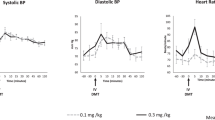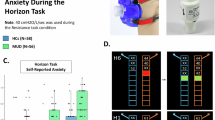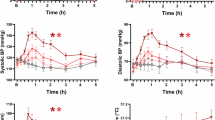Abstract
Recent preclinical evidence suggests that repeated exposure to 3, 4-methylenedioxy-methamphetamine (MDMA; “ecstasy”) produces long-term reductions in serotonin (5-HT) levels. 5-HT has been implicated in the regulation of mood, anxiety, aggression, impulsivity, and cognition. Accordingly, in the first of two separate studies, these variables were investigated in three groups: (1) MDMA group—recreational ecstasy users (who also used other illicit substances); (2) polydrug controls—who had never taken ecstasy, but otherwise had drug histories and personal characteristics similar to the ecstasy users; and (3) nondrug controls—who had never used illicit drugs, but had similar personal characteristics. All participants completed mood (Likert) scales, personality questionnaires (which included the impulsiveness, venturesomeness and empathy questionnaire–IVE), spatial span and “Tower of London” (TOL) tests, and a behavioural measure of impulsivity, the matching familiar figures test (MFF20). There were no group differences in mood, anxiety, anger/hostility, and cognitive performance, but the MDMA group committed significantly more errors in the MFF20. Subsequently, a larger sample of participants were administered mood (the General Health Questionnaire or GHQ) and personality (IVE) questionnaires before the administration of a TOL test, followed by the MFF20, and a second TOL test. Although there were no group differences in TOL performance, ecstasy users were again found to commit more errors in the MFF20 than polydrug users. Furthermore, the GHQ and IVE scores of the ecstasy users in the second study indicated, respectively, that they were more psychologically disturbed and impulsive than nondrug controls. The combined data from the two studies indicated that ecstasy users exhibited elevated impulsivity on both self-report and behavioral measures and that those who had taken the most ecstasy had the most elevated trait impulsiveness scores. These findings are consistent with previous evidence that elevated levels of impulsivity in humans are associated with reduced levels of serotonergic function.
Similar content being viewed by others
Log in or create a free account to read this content
Gain free access to this article, as well as selected content from this journal and more on nature.com
or
References
Baddeley A . (1990): Human Memory: Theory and Practice. Boston, Allyn & Bacon, Inc
Block J, Block JH, Harrington DM . (1974): Some misgivings about the Matching Familiar Figures Test as a measure of reflection impulsivity. Child Devel 47: 218–226
Callow N . (1996): Use of the “snowballing” technique to investigate subjective mood and personality traits associated with “ecstasy.” Proceed Brit Psych Soc 4: 65
Cairns E, Cammock T . (1978): Development of a more reliable version of the Matching Familiar Figures Test. Dev Psychol 13: 555–560
Curran HV, Travill RA . (1997): Mood and cognitive effects of 3,4-methylenedioxymethamphetamine (MDMA, “ecstasy”): Weekend “high” followed by mid-week low. Addiction 92: 821–831
Davies G . (1996): Investigation of subjective mood and personality traits associated with recreational use of “ecstasy.” Proceed Brit Psych Soc 4: 65
Delgado L, Charney DS, Price LH, Aghajanian GK, Landis H, Heninger GR . (1990): Serotonin function and the mechanism of antidepressant action: Reversal of antidepressant-induced remission by rapid depletion of plasma tryptophan. Arch Gen Psychiat 47: 411–418
Eysenck HJ, Eysenck SBG . (1991): Adult Impulsiveness, Venturesomeness, and Empathy Scale. London, UK, Hodder & Stoughton, Ltd
Frederick D, Paule M . (1997): Effects of MDMA on complex brain function in laboratory animals. Neurosci Biobehav Rev 21: 67–78
Garvey MJ, Noyes R, Woodman C, Laukes C . (1995): Relationship of generalized anxiety symptoms to urinary 5-hydroxyindoleacetic acid and vanillylmandelic acid. Psychiat Res 57: 1–5
Gerbing DW, Ahadi SA, Patton JH . (1987): Toward a conceptualization of impulsivity: Components across the behavioral and self-report domains. Multivariate Behav Res 22: 357–379
Goldberg D . (1978): General Health Questionnaire. Windsor, UK, NFER-Nelson Publishing Company, Ltd
Green AR, Cross AJ, Goodwin GM . (1995): Review of the pharmacology and clinical pharmacology of 3,4-methylenedioxymethamphetamine (MDMA or ecstasy). Psychopharmacology 119: 247–260
Hunter A . (1988): Serotonergic involvement in learning and memory. Biochem Soc Trans 17: 79–81
Kagan J, Rosman BL, Day D, Albert J, Phillips W . (1964): Information processing in the child: Significance of analytic and reflective attitudes. Psychol Mono 78(1, Whole No. 587)
Krystal JA, Price LH . (1992): Chronic 3,4-methylenedioxymethamphetamine (MDMA) use: Effects on mood and neuropsychological function. J Drug Alcohol Abuse 18: 331–341
Linnoila M, Virkkunen M, George T, Higley D . (1993): Impulse control disorders. Int Clin Psychopharm 8: 53–56
McCann UD, Ridenour A, Shaman Y, Ricuarte GA . (1994): Serotonin neurotoxicity after MDMA (“ecstasy”): A controlled study in humans. Neuropsychopharmacology 10: 129–138
McKenna DJ, Peroutka SJ . (1990): Neurochemistry and neurotoxicity of 3,4 methylene-dioxymethamphetamine (MDMA; ecstasy). J Neurochemistry 54: 14–22
Messer SB, Brodzinsky DM . (1981): Three year stability of reflection-impulsivity in young adolescents. Dev Psychol 17: 848–850
Nelson H . (1982): National Adult Reading Test, Windsor, UK, NFER-Nelson Publishing Company, Ltd
Owen AM, Downes JJ, Sahakian BJ, Polkey CE, Robbins TW . (1990): Planning and spatial working memory following frontal lobe lesions in man. Neuropsychologia 28: 1021–1034
Parrott AC . (1997): MDMA, mood, and memory: The agnosia of the ecstasy. Brit Psych Soc Proc 5: 49
Ricaurte GA, Finnegan KT, Irwin I, Langston JW . (1990): Aminergic metabolites in cerebrospinal fluid of humans previously exposed to MDMA: Preliminary observations. Ann NY Ac Sci 600: 699–710
Salkind NJ, Wright J . (1977): The development of reflection-impulsivity and cognitive efficiency: An integrated model. Human Dev 20: 377–387
Saunders N . (1995): Ecstasy and the Dance Culture. London, UK, Neal's Yard Publishing
Shallice T . (1982): Specific impairments in planning. Phil Trans R Soc Lond B 2948: 199–209
Smith SE, Pihl RO, Young SW, Ervin FR . (1987): A test of possible cognitive and environmental influences on the mood lowering effect of tryptophan depletion in normal males. Psychopharmacology 91: 451–457
Spielberger CD . (1988): State-Trait Anger Expression Inventory. Odessa, FL, Psychological Assessment Resources, Inc
Spielberger CD, Gorsuch RL, Lushene R, Vagg PR, Jacobs GA . (1983): Self-Evaluation Questionnaire. Palo Alto, CA, Consulting Psychologists Press Inc
Spoont MR . (1992): Modulatory role of serotonin in neural information processing: Implications for human psychopathology. Psych Bull 112: 330–350
Steele TD, McCann UD, Ricuarte GA . (1994): 3,4-Methylenedioxymethamphetamine (MDMA, “ecstasy”): Pharmacology and toxicology in animals and humans. Addiction 89: 539–551
Szabo Z, Scheffel U, McCann U, Dannals RF, Ravert HT, Mathews WB, Musachio JL, Ricaurte GA . (1997): Reductions of 5-HT transporters in MDMA users observed using PET with [C-11]{+}McN5652. Soc Neurosci Abstr 123: 2–23
Traskman-Bendz L, Asberg M, Schalling D . (1986): Serotonergic function and suicidal behavior in personality disorders. Ann NY Ac Sci 487: 168–174
Wilson B, Cockburn J, Baddeley A . (1985): The Rivermead Behavioural Memory Test. Thames Valley Text Co, Reading, UK
Wolff K, Hay AWM, Sherlock K, Conner M . (1995): Contents of “ecstasy.” Lancet 346: 1100–1101
Young SW, Smith SE, Pihl RO, Ervin FR . (1985): Tryptophan depletion causes rapid lowering of mood in normal males. Psychopharmacology 87: 173–177
Acknowledgements
The author thanks Gareth Davies, Clare Edwards, Richard Green, Laura Grundy, Joanne Hughes, Rachel Hunter, and Alison Kewell for their contribution to the recruitment and assessment of participants.
Author information
Authors and Affiliations
Rights and permissions
About this article
Cite this article
Morgan, M. Recreational Use of “Ecstasy” (MDMA) Is Associated with Elevated Impulsivity. Neuropsychopharmacol 19, 252–264 (1998). https://doi.org/10.1016/S0893-133X(98)00012-8
Received:
Revised:
Accepted:
Issue date:
DOI: https://doi.org/10.1016/S0893-133X(98)00012-8
Keywords
This article is cited by
-
Impaired Outcome Evaluation During Risky Decision-Making in Individuals with Methamphetamine Use Disorder
International Journal of Mental Health and Addiction (2024)
-
An observational study on the sub-acute effects of mephedrone on mood, cognition, sleep and physical problems in regular mephedrone users
Psychopharmacology (2018)
-
“Ecstasy” toxicity to adolescent rats following an acute low binge dose
BMC Pharmacology and Toxicology (2016)
-
Increased response conflict in recreational cocaine polydrug users
Experimental Brain Research (2014)
-
Are executive function and impulsivity antipodes? A conceptual reconstruction with special reference to addiction
Psychopharmacology (2012)



